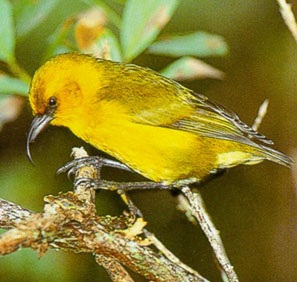DLNR Celebrates A New Christmas Tradition To Protect Hawai‘i’s Rarest Birds
Posted on Dec 5, 2013DEPARTMENT OF LAND AND NATURAL RESOURCES
News Release
| NEIL ABERCROMBIE GOVERNOR |
WILLIAM J. AILA JR,
CHAIRPERSON |
For Immediate News Release December 5, 2013
DLNR CELEBRATES A NEW CHRISTMAS TRADITION
TO PROTECT HAWAI‘I’S RAREST BIRDS
KULANI, HAWAI‘I – A new Christmas tradition is taking place in remote forests above Hilo. Early in the morning, volunteers scan the trees, looking for jewels far more beautiful than any Christmas ornament. These volunteers are on a quest to find Hawai‘i’s rarest native birds. The forests of Kulani are part of the Pu‘u Maka‘ala Natural Area Reserve (NAR) managed by the Department of Land and Natural Resources (DLNR) Division of Forestry and Wildlife (DOFAW).
On Saturday, Dec. 14, 2013, the DLNR Natural Area Reserves System (NARS), the Three Mountain Alliance (TMA), and the Hawai‘i Audubon Society and community volunteers will search through the forest and count native birds in an annual survey of the forest.
The objective of the count is to collect bird population data from which researchers, conservation biologists, and other interested parties may study the long-term status of bird populations. It provides a picture of how bird populations have changed in time and space over time.
Volunteers and birders may see ‘ōma‘o, ‘i‘iwi, nēnē, ‘elepaio, ‘apapane, ‘akiapōlā‘au, ‘amakihi, ‘akepa, ‘io and Hawai‘i Creeper.
This is the fifth year that Christmas Bird Counts will be held in Kulani and the 114th since the Audubon Society started this family tradition nationally. Volunteers will be paired with expert bird watchers to record all sightings or sounds of the birds.
BOX: All volunteer slots have been filled, but to put your name on a wait list or for more information contact Anya Tagawa at [email protected] or call (808) 443-4245.
“The Pu‘u Maka‘ala Natural Area Reserve at Kūlani is one of the last refuges for Hawai‘i’s native birds. This free event gives the community a rare chance to see these beautiful species,” said Anya Tagawa, NARS education coordinator.
One of the native birds viewable at the Pu‘u Maka‘ala NAR is the endangered ‘Akiapōlā‘au, a Hawaiian Honeycreeper only found on the Big Island. This bright yellow bird has evolved to fill the role occupied by woodpeckers in many other parts of the world. It creeps along trunks and branches tapping holes in the rotten bark with its lower beak and extracts grubs and other insects with its sharply curved upper beak.
“The annual Christmas bird count is a great opportunity for the community to experience what makes Hawai‘i so unique,” said Lisa Hadway, branch manager of Hawai‘i Island DOFAW. “Our goal is to foster a better understanding of our native species and places we are so privileged to protect.”
More than half of Hawai‘i’s native forest has been lost, leaving little habitat left for these birds. In turn, more than half of Hawai‘i’s forest bird species have gone extinct, and almost all populations are declining.
“These surveys help us keep track of how the various populations are doing, and where they remain,” said Hadway. “Then, the DLNR can focus its efforts to where they protect forests from invasive species.”
In addition to saving native species, forest protection secures Hawai‘i’s water supplies. Hawai‘i’s native forests collect rain and fog, providing water for human use. Forests also prevent erosion that muddies beaches and reefs.
# # #
Media Contact:
Deborah Ward
Public Information Specialist
(808) 587-0320



